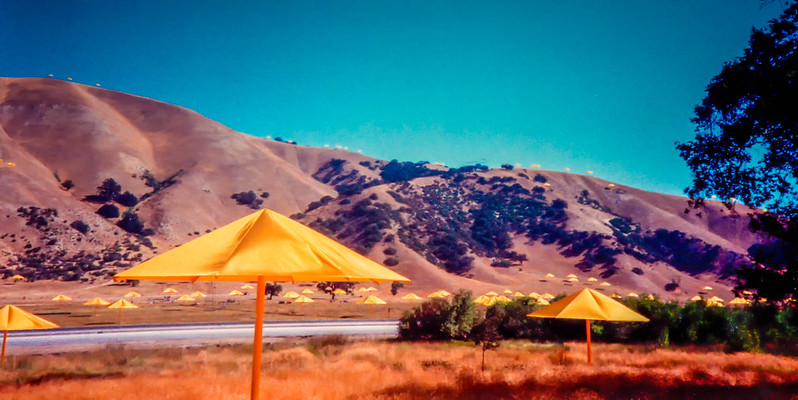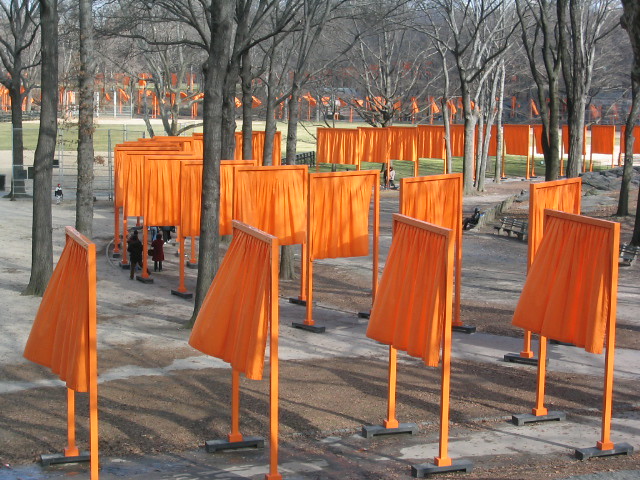Cities are made of asphalt and concrete, gasoline and dollar bills, joy and strife. For me, one of the most influential figures worked in wind, sun, and fabric.
The artist Christo died this week. Born in Bulgaria and based in New York City, he and his late wife Jeanne-Claude (deceased in 2009) — never was there a more elegant dual mononymic couple — invented and, across decades and continents, continually reinvented their own genre of landscape art. Their images are as indelible as they are surprising: pink islands, orange paths leading nowhere, buildings softened and shimmery.
Their early work grew out of the land art movement of the 1960s and ‘70s, unfurling reams of fabric on desolate natural environments. They hung an enormous curtain across a canyon in Colorado, and they celebrated the landscape of California with 1976’s Running Fence, a 25-mile-long, 18-foot-high strip of fabric running over hill and dale westward from Sonoma County, across Marin County, and into the Pacific at Bodega Bay. They returned to California in 1991 to erect one half of The Umbrellas, in which hundreds of larger-than-life yellow umbrellas were planted in the Grapevine Pass north of Los Angeles. The other half of the piece consisted of blue umbrellas in Japan.
As much as we may appreciate an untrammeled landscape, I think we can agree that there are moments when human imagination and natural grandeur complement each other in captivating ways.
It was in cities, though, where Christo’s whimsy reached its full force: islands in Miami’s Biscayne Bay surrounded by hot pink aprons; Paris’ most important bridge, the Pont Neuf, draped in ivory-colored nylon, reflecting the lights of the world’s most romantic city; the entire Reichstag in Berlin, trussed up like a special delivery; saffron-colored curtains winding through Central Park. Next summer, Christo will posthumously wrap the Arc de Triomphe.
 |
| The Umbrellas, along I-5, in 1991. |
I grew up in a family of Christo fans. We had posters and prints (revenue from which funded the actual pieces) and went on outings to see pieces in situ. They have their detractors, of course, in people who think his work is ugly, irreverent, or pointless. But I was always thoroughly charmed. A cliche about art is that it is supposed to help people see the world differently. Christo literally made the world look different.
But those playful, innocent aesthetics belie Christo’s larger purpose. To state the obvious: global landmarks do not wrap themselves.
In college, I majored in English, so I was contentedly steeped in novels, plays, and essays. But when Christo and Jeanne-Claude spoke on my campus, I of course attended. And it was there — at a lecture on visual art, of all things, by two of the least bureaucratic people you could imagine — that I discovered land use policy.
Christo’s pieces are no mere “public art,” like the typical sculpture deposited arbitrarily in the plaza of an office building or the median of a boulevard (often paid for as penance by a developer). And they aren't just place-based. They are based in, and rely upon, specific places that are unique and irreplaceable. And they don’t just occupy those places. They borrow those places. They use and transform them, and then they give them back.
Christo didn’t wrap just any bridge. He wrapped the Pont Neuf. He didn’t wrap just any capital building. He wrapped the Reichstag. He didn’t try to cover just any river. Only a certain stretch of Colorado’s Arkansas River fit his specifications for a five-mile fabric cover (which was ultimately abandoned). Walter Benjamin questioned the purity of art in the face of the ability to reproduce it mechanically. Christo brought it back by creating pieces that are literally unreproducible.
 |
| The Gates, in New York City's Central Park, in 2005. |
By wedding his art to specific places, Christo committed himself to the mundane business of public policy. He didn’t wander around Europe looking for governments willing to give up their bridges. He fought, pressured, and cajoled the Parisian government for permission to wrap that specific bridge. He didn’t get turned down by Berlin and decide he’d try Sacramento instead. He went all the way to Mayor Bloomberg so he could erect over 7,000 “gates” on Frederick Law Olmsted’s turf. He worked with cities. He convinced them that whimsy can comport with the public interest. He made all the mundane assurances: safety, security, accessibility, financial solvency, liability, and all the rest.
Art is supposed to be about freedom: With a brush and a canvas, a keyboard and a mixer, a pen and paper, you can create anything, right? But what if your art requires a permit? What if your art requires consent of a landlord? What if your art might block views or impact ecosystems? What if your art might fall on someone? What if it blocks egress or impedes the right of way?
These are questions most artists (like most people) deliberately avoid. Art is the opposite of bureaucracy. Artists retreat to their studios to avoid tedious questions such as these. But Christo embraced the tedium. He met it head-on, and he figured out how to triumph over it (and even Triomphe over it). He did so because, in addition to clearly loving the sport of it, he knew that the result would be worthwhile.
Consider the gauntlet Christo had to run when he created Running Fence. He needed permission from two counties, 59 private landowners, and the California Department of Transportation. He presented at 18 public meetings and two court hearings, and he had to commission an environmental impact report. The process took four years, for a piece that existed for 14 days.
Every developer reading this is hereby in awe of Christo.
Formally, Christo's work seems aggressive apolitical, and it is. But Christo himself was never apolitical. His politics aren’t in his artwork — politics enable his artwork.
Unlike many other political animals, Christo used politics for the better. He does the hard work of lobbying so that people can experience joy. And, unlike, say, his contemporary Jeff Koons, who spends relatively little money to create pieces that he sells for eight figures, Christo spent small fortunes preparing works that he gave away for free. How’s that for a special interest?
Christo, like his art, is sui generis. But everyone who works in and with the public realm can learn from him.
Four years to get a permit for a fence — that literally vanished without a trace? Christo was messing with us. He knew that bureaucracy is a farce, and he toyed with it even as he was probably infuriated by it. Cities need to speed it up, whatever “it” may be, so we can get to the good stuff before we all keel over.
Here’s where traditional planning and development parts ways with art. If you don’t like Christo’s work, that’s your loss. But it doesn’t really matter. His work is temporary (and costs nothing). You get to hate it for only a week or two, if you see it at all.
Let’s get excited about the things that really matter. Let’s get excited about a low-income housing development. Let’s get excited about services for the homeless. Let’s get excited about complete streets. Let’s get excited about equity and opportunity. Let’s get excited about creativity — both the process and the result. And, yes, let’s get excited about public art.
If we look closely enough, we can see that Christo and Jeanne-Claude have revealed regulation for us. That is their enduring unwrapped gift. We don’t have them to help us anymore. It’s up to the rest of us, planners, developers, and citizens alike, to decide whether to make it ugly or beautiful, elitist or equitable.
The lesson for planners: Take a risk. And make it easier for good things to happen. If it’s good enough for Paris, good enough for Berlin, good enough for New York City, then a little whimsy is good enough for every city.
Christo is gone. Jeanne-Claude is gone. Their pieces came and went. But great cities endure. Planners who take inspiration from them can make their cities just a little greater, and a little more enduring.
Umbrellas image courtesy of Kenneth Hagemeyer via Flickr.
Gates image courtesy of Chad Fennell via Flickr.